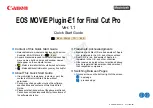
How Voice Processing Operates
User ID Mailboxes
3-4
Strata CIX40 Voice Processing Programming Manual 7/06
User ID Mailboxes
Types of Mailboxes
User IDs fall into one of several general categories, based on how they are customized.
User
A typical User ID mailbox records messages from callers. A user can periodically check the
User ID for messages, or be notified by a variety of automatic notification methods. Typically,
there is one user for each User ID, although several User IDs may share a single extension
because the users themselves share a single telephone line.
Information
An information User ID mailbox does not accept messages from callers. Instead, voice
processing plays its greeting to callers in order to provide them with information, such as the
company’s hours of operation and location. No user or telephone extension corresponds to
this type of User ID.
Control
Using voice processing’s Token Programming Language, a control User ID mailbox, directs
the flow of a call. Typically, it interacts with the caller in some way, then transfers the call to
one or more additional User IDs for further processing.
For example, a User ID might ask the caller to input his or her telephone number. If the
telephone number is seven digits long, voice processing assumes it is valid and the User ID
passes control to a second User ID that makes use of that telephone number in some way
(such as faxing a document to it). If the telephone number is not seven digits long, voice
processing might transfer to a third User ID, which would be an information box whose
recording informs the caller that the telephone number was not the right length. The User ID
might then transfer control back to the original User ID to give the caller another chance to
enter the correct number of digits.
Customizing Mailboxes
Customizing User ID mailboxes involves defining User IDs using the following menus:
•
Users Menu
—The Users Menu consists of three screens (Info/Status, Options, Group/
Chains) that enable you to define, delete, and list User ID mailboxes. Features to define
include: company directory entries, Do Not Disturb, Call Screening, Greetings, and control
structures such as Chains, Groups, and Menus. Once you have defined and saved a User
ID, you can customize it using the Auto and Notify Menus. (See
for
detailed information.)
•
Auto (Scheduling) Menu
—With the Auto Menu, you can set up automatic changes for
each User ID Mailbox. You can set these changes to occur at a specified time, on certain
days of the week, or on a specified date. For example, you can set up different daytime and
nighttime greetings. (See
“Auto (Scheduling) Menu” on page 4-20
•
Notify Menu
—The Notify Menu enables you to program voice processing to automatically
call a user to notify him of messages. Notification methods include beepers, other
telephones, and office paging systems. (See
information.)
In addition to the programming capabilities provided by the Users, Auto, and Notify Menus,
voice processing provides:
•
Token Programming Language
—Enables you to obtain additional features. These
include obtaining information from callers and message waiting light control. See
for details.
Содержание Strata CIX GVPH
Страница 10: ...This page is intentionally left blank ...
Страница 102: ...This page is intentionally left blank ...
Страница 122: ...This page is intentionally left blank ...
Страница 144: ...This page is intentionally left blank ...
Страница 152: ...This page is intentionally left blank ...
Страница 176: ...This page is intentionally left blank ...
Страница 184: ...This is the last page of the document ...
















































